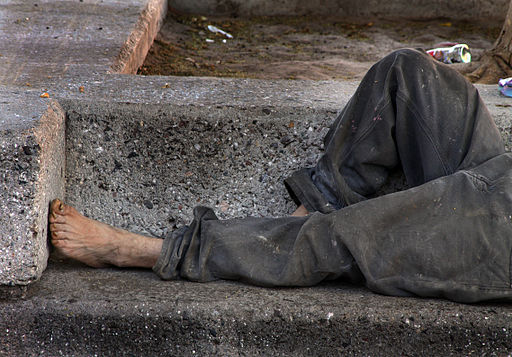 | |||
| Homeless on a Bench |
Image by Tomas Castelazo, CC BY-SA 3.0, via Wikimedia Commons
Obviously we need long term solutions for homelessness. We need to address structural factors such as unemployment and commodification of housing which are making housing unaffordable for many. As well as creating affordable housing we need to prevent people becoming homeless in the first place. We also need to end criminalisation of the homeless and provide support for those who are on the streets because of mental illness or addiction. The immediate rewards for communities which take action include reduction in crime, the costs of law enforcement and hospital costs and fewer unsightly and unsafe neighbourhoods. However, since the wheels of government turn slowly, many places and organisations are working to make life safer and more bearable for those already on our streets. I am mentioning some of them here for inspiration but most would also appreciate any support you can give whether by way of donation or as a volunteer.
Interim help for the homeless
Here in Hobart for example, we have a mobile medical service and Louie’s Food Van which collects surplus food from food outlets at the end of the day and delivers it to the homeless. One of the more original services is A Paw Up which has monthly popup clinics in the park for the pets of the homeless and disadvantaged. It also provides emergency food and boarding for those unable to care for their pets. Another is Orange Sky Laundry begun in 2014 and which provides mobile laundry services and showers in 35 locations around Australia and New Zealand.This not dissimilar to Lava Mae which has been providing showers and sanitation for California's homeless since 2014.
Shelter
Several companies are making portable shelters to provide privacy and protection from the weather. These range from tentlike arrangements such as the Aussie- made Streetswags or the EPWR Coat which doubles as a sleeping bag to the tiny homes being produced by a Canadian man and the weatherproof Pods being used in Germany. Top of the range is most probably the CITYSPACE MicroPAD (USA) - a furnished modular self -contained prefab and portable unit with its own bathroom. [Perhaps Australia could invest in some as instant quarantine facilities].
In London, retired double -decker buses are being converted by Bus4Homeless into mobile shelters by Some become mobile dining rooms while others have spaces for activities such as Yoga or learning cooking or business skills. Elsewhere in the UK 11 homeless hubs have been established which provided shelter for rough sleepers and access to a range of specialist services.Beddown is an Australian innovation started by Norm Millivrai in Brisbane in 2019. Millivrai whose own father died on the streets of London in his 40’s, transforms empty spaces such as deserted parking garages into pop up accommodation for the homeless at night. As well as providing a safe place to sleep, Beddown has medical services and hairdressers on hand to prevent the physical and mental deterioration which are often part of the homeless experience and to which sleep deprivation itself often contributes.
Employment and training
- On the subject of training a London based Coffee Company Change Please, trains and employs baristas to run coffee vans for street –side sales or at events.
- The production of the EPWR coat (see above) also provides employment and training for homeless parents.
- In Los Angeles homeless people are being employed to guard empty homes and construction sites
Technology to the rescue
At night when the temperature drops below 7oC in Stockholm, Clear Channel, a Swedish company which has thousands of electronic billboards around the city, switches them to show the location of the nearest shelter. Several companies have also produced apps such as GiveSafe or WeCount (see below) or the Helping Heart Jacket by N= 2 (Amsterdam) which enable the homeless to obtain donations or goods they need without having to beg overtly which is illegal in many places. See Mashable for more on these.
Afterthoughts
Wonderful as these ideas are - and I’m sure there are many more, we should also keep in mind the bigger picture. Even if countries manage to solve their own homelessness problem, we still need to look out for our neighbours. Otherwise we will be in the same situation as Salt Lake City, with people flooding in from surrounding regions. If we do not raise their living standards we will continue to have more and more economic migrants. Similarly, if we do not concern ourselves with climate change we will continue to have not only internally displaced people due to fire, flood and increasing cyclone activity and so on, but also those who are fleeing even worse conditions in other countries such as sea level rise, famine, prolonged drought or conflict due to same. While the first claim for asylum due to climate change - a man from Kiribati, has been dismissed, the case has opened the way for future claims. The UN estimates that there will be in the order of 150 million people being dislocated in coming years if we do not make a concerted effort now not only to prevent climate change but prepare for its ongoing effects so that people can remain where they are, rather than adding to the homeless populations elsewhere.
Comments